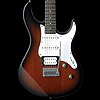
Back Tremolo (Gitarre) German Τρέμολο Greek Tremolo Spanish Tremolokang Estonian Vibrakampi Finnish Vibrato (guitare) French Vibrato, sustav za gitaru Croatian Tremoló (hangszerrész) Hungarian Tremolo (chitarra elettrica) Italian ビブラート・ユニット Japanese
This article needs additional citations for verification. (April 2012) |
A vibrato system on a guitar is a mechanical device used to temporarily change the pitch of the strings. It adds vibrato to the sound by changing the tension of the strings, typically at the bridge or tailpiece of an electric guitar using a controlling lever, which is alternately referred to as a whammy bar, vibrato bar, or tremolo arm.[1] The lever enables the player to quickly and temporarily vary the tension and sometimes length of the strings, changing the pitch to create a vibrato, portamento, or pitch bend effect. Instruments without a vibrato have other bridge and tailpiece systems.
The pitch-bending effects have become an important part of many styles, allowing creation of sounds that could not be played without the device, such as the 1980s-era shred guitar "dive bomb" effect.
The mechanical vibrato systems began as a device for more easily producing the vibrato effects that blues and jazz guitarists had achieved on arch top guitars by manipulating the tailpiece with their picking hand. Guitar makers have developed a variety of vibrato systems since the 1890s.[2]
A vibrato-equipped guitar is typically more difficult to re-string and tune than a fixed-tailpiece guitar.[3]
Since the regular appearance of mechanical vibrato systems in the 1950s, many guitarists have used them—from Chet Atkins to Duane Eddy and the surf music of The Ventures, The Shadows, and Dick Dale. In the 1960s and 1970s, Jimi Hendrix, Jeff Beck, David Gilmour, Ritchie Blackmore, Jimmy Page,[4] and Frank Zappa used vibrato arms for more pronounced effects. In the 1980s, shred guitarists Eddie Van Halen, Eric Johnson, Joe Satriani and Steve Vai, and metal guitarists Kerry King, Ritchie Blackmore, Kirk Hammett, Terje Rypdal, Vernon Reid, David Torn and David Duhig used vibrato in a range of metal-influenced styles, many aided by the development of the double-locking design pioneered by Floyd Rose or the later Kahler, which eliminated many of the tuning issues associated with more basic designs and allowed guitarists to employ dramatic "dive bomb" effects freely throughout a performance.[5]
- ^ "Guitar Player - Lessons". Guitar Player. 29 September 2023.[not specific enough to verify]
- ^ US application 607359, Albert J. Forrest, "Stringed Musical Instrument", published 1898-07-12, filed 1897-09-14.
- ^ Hebenstreit, Daniel (June 2018). "Tuning a musical instrument with vibrato system: A mathematical framework to study mechanics and acoustics and to calculate optimal tuning strategies" (PDF). J. Acoust. Soc. Am. 143 (6): 3231–3241. Bibcode:2018ASAJ..143.3231H. doi:10.1121/1.5039846. PMID 29960433. S2CID 49640044.
- ^ "Jimmy Page's 40-Year les Paul Legacy". Archived from the original on 9 March 2012. Retrieved 29 April 2012.
- ^ Ganaden, Gerry (April 2009). "Trem Wars: The Whammy Arms Race". Premier Guitar: 4. Archived from the original on 26 March 2012. Retrieved 7 October 2010.


